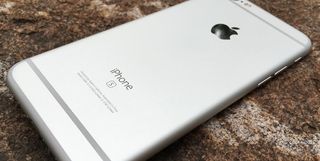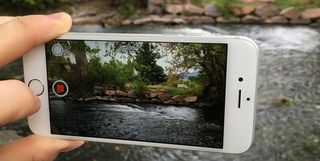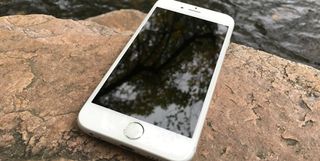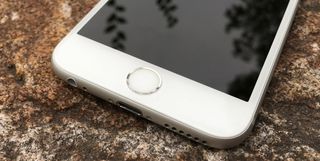You can still buy the iPhone 6s second-hand, and it's a solid phone. Our original review of the 6s is below, but if you're looking for something more modern, you should consider our best smartphones guide, or look at our iPhone 11 review. If you want to go super high-end, take a look at our iPhone 11 Pro review.
At this point, everyone in America has heard of the iPhone. It’s a cultural touchstone, an element of our society as pervasive as the smartphone itself. That’s no surprise, considering Apple pioneered much of what we consider smart about smartphones. Keyboardless input, multitouch screens, the idea of using your phone as your media player – before the iPhone, none of these had been considered, much less considered standard.
Yet the iPhone doesn’t exist in a vacuum. Google’s Android is, depending on whom you ask, a better mobile operating system; at the very least, it’s far more customizable. Samsung almost single-handedly defined the feature-first marketplace, where the best products have the biggest numbers and more checked boxes in smartphone reviews than anyone else. Apple’s phones don’t have the highest resolutions or the biggest batteries. They’re not water-resistant, they can’t charge wirelessly without third-party accessories, and they still don’t offer expandable storage. So why do we care?
Because despite all the things the iPhone lacks, it still has a lot to care about. The iPhone 6s has one of the best smartphone cameras ever made, the fastest processors, and consequently, the smoothest user experiences. It offers the best selection of applications and accessories, and its metal and glass design defines the industry’s standard of elegance.
Apple iPhone 6s: What's on offer

We had more than a few nice things to say about the iPhone 6 when it came out last year, and to all but the most exacting eye, the iPhone 6s appears no different. It’s slightly bulkier and heavier than its older sibling, but this isn’t noticeable without a scale and ruler. This is an S year, after all, when Apple forgoes radical design changes and instead polishes what it released the year before.
As such, you get the same 750 x 1334 display as last year’s model, with the same 326 PPI pixel density. Next to the ludicrously high-resolution screens of the competition’s top smartphones, you might think we’d be underwhelmed – after all, the Galaxy S6 packs an insane 577 PPI, which is almost 333,000 pixels per square inch. Still, we have zero qualms about the iPhone 6s’ screen. It’s rich, saturated and crisp, with nary a pixel visible to the naked eye. If you ever needed proof that high-resolution screens are more gimmick than improvement, it’s right here.
The latest release of Apple’s mobile operating system, iOS 9, continues to take cues from Android. After so long leading other innovators, the backseat Apple’s taken to software design feels unbecoming.
Siri is now slightly better at recommending apps and search results based on time and your location, but the recommendation engine remains inferior to Google Now. A contextual back button now appears in the top-left corner in place of the carrier signal pips, letting you head back to previous apps, but the implementation feels like an afterthought, and its position makes it all but impossible to use with one hand.
We’d be utterly nonplused were it not for the continued supremacy of the App Store. Not a big fan of the Mail app? There’s always Outlook or Google Inbox. Apple Maps does a poor job of routing you through traffic, but that’s what Google Maps is for. In truth, few of Apple’s native apps are worth your time, but thanks to the App Store, you needn’t use them. If there was a way to default Siri to Google Maps and Google Search, we’d be set for life.
Apple iPhone 6s: Camera

Nowhere is Apple’s smartphone supremacy more evident than in its cameras. The iPhone 6s continues the company’s long reign with newly improved lenses on both sides of the device. By the numbers, they’re still less impressive than what most other modern flagships can deliver, but in terms of pure quality, they’re unmatched.
The rear-facing camera now takes 12MP photos and shoot 4K video. Those extra megapixels don’t make the resulting photos much bigger, but when combined with Apple’s image processing, they supply even more clarity to already exquisite shots. Focus pixels, dual-LED flash and 240 fps slow-motion video all return, but the real value here is in the phone’s ability to capture superb shots without fiddling with settings.
The front-facing camera also received a sizable upgrade, jumping from a 1.2MP to a 5MP sensor. Selfies are far sharper and look noticeably improved in dim lighting, and Apple even tuned the phone’s display to act as a surrogate flash. Just like the dual-LED flash on the back, the front display lights up to match the color tones of the environment, and shines – according to Apple – three times brighter than the usual maximum screen brightness in a sort of faux-flash. The new 5MP lens does a great job of picking up exposure, so you don’t actually need the flash, but it’s nice to have in a pinch.
Whether it’s because it has fewer pixels to push around that lower-resolution 750 x 1334 screen, or simply because it has some impressive silicon packed away, Apple’s new A9 chip decimated our benchmark tests. Its Geekbench 3 scores were solid, if not quite as impressive as what we’ve come to expect from Qualcomm’s Snapdragon 810 chips. Its 3D Mark scores, on the other hand, were several thousand points higher than the competition.
But the real stunners were the phone’s GFXBench scores, which skyrocketed at several times the number of rendered frames of the next best device, Samsung’s Galaxy Note5. You can take a look at a sampling of our benchmark results using the comparison tool at the top of the page, but the takeaways are simple:
Apple iPhone 6s: Storage
The iPhone’s processor is impressive; its storage options, less so. Without support for microSD cards, you have to make do with the built-in storage that comes with whichever model of iPhone 6s you buy. The entry-level version offers a measly 16GB, which simply isn’t enough in this day and age, especially now that the 6s can shoot 4K video and take even bigger photos. Given how ridiculously cheap storage has become, keeping the entry-level phone at 16GB seems like a warrantless money grab. If you can afford it, upgrade to the 64GB version.

In order to make room for its new 3D Touch display, Apple decided to downsize the battery in the iPhone 6s. Last year’s iPhone 6 packed 1810 mAh of power storage; this year, you only get a 1715 mAh cell. Fortunately, the downgrade doesn’t have a negative effect on performance; to the contrary, the 6s managed slightly better in our longevity tests than its year-old brethren.
Our intensive-use tests were a different matter. Put through three grueling, processor-heavy churns meant to simulate maxed-out gaming and hard computation, the iPhone 6s managed an average of just three hours and 32 minutes. That’s not a lot – the Galaxy Note5 managed to last three times as long in the same test – but then, the Note5’s longevity test results weren’t much more impressive than the iPhone 6s’s.
Given how ridiculously well the 6s performed in our gaming benchmarks, we’re pretty sure the disparity in performance comes down to graphics processing. The iPhone can handle itself better during gaming sessions at the cost of battery life; in casual use, it performs admirably. Of course, without a swappable battery or quick or wireless charging, there’s no easy way to juice up: It took us almost an hour to bring an empty iPhone 6s back up to a 50 percent charge.

There are certain things you can expect a new iPhone to have, like Bluetooth 4.2 – an obvious necessity that Apple has again included in its latest device. Likewise, NFC support is a guarantee, seeing as Apple Pay relies on the technology to let you make contactless payments all across America. Then there are the features that set the iPhone apart: Touch ID and 3D Touch.
Apple iPhone 6s: Touch ID
Apple wasn’t the first company to put fingerprint scanners on their phones, but they did it best. Having extensively used both the Samsung and Apple takes on fingerprint security, we’ve consistently been happier with Touch ID’s performance. It’s easier to cover the entire scanner with your finger, setup is more intuitive, we get fewer bad reads, and the speed of the new, second generation Touch ID is incredibly fast. In the time it takes to press the home button and turn the screen on, Touch ID manages to grab your print, verify it and unlock the device. There’s still a learning curve as you train a bit of muscle memory into your fingers, but it’s superior to the competition.
Apple iPhone 6s: 3D Touch

We have mixed feelings about 3D Touch. In case you haven’t heard of it, 3D Touch is a force-sensitive technology that measures the amount of pressure you apply to the iPhone’s screen. It’s a linear sensor, so the phone reacts to precisely the amount of force you apply. As you increase that force, iOS responds in kind. On the phone’s animated lock screens, for example, you can control the speed of the animation forward and backward by applying different amounts of pressure.
3D Touch is essentially a right-click for your phone. You can still tap on icons to launch apps, tap on photos to view them full-screen or tap on emails to read them as you always have. If you choose to push down instead, however, you get different actions. If you’re on the home screen and you push on an icon, you get a pop-up menu with shortcuts to various in-app functions, like “New Message” in the Mail app. If you’re already in an app, pushing down lightly lets you “peek” into something like a mail message or photo, giving you a preview that goes away as soon as you release your finger. Push a little harder, and the message or photo “pops” into place, letting you further manipulate it in full screen.
Peek and pop are the fundamental new paradigms of the iPhone 6s, and they work because they’re simple. Successful 3D pushes give a satisfying click from the phone’s new taptic engine, almost like you’re clicking on a laptop’s trackpad. If an app on the home screen doesn’t support 3D Touch – which is pretty common at the moment, considering only Apple and a handful of third-party developers have been able to implement support – it gives a quick triple-click response, like a parent wagging their finger.
So yes, 3D Touch works, and it’s surprisingly fun to use. But it’s also a bit of an annoyance. Even on the lightest feedback settings, we always had to use slightly more force than expected to elicit a response. With more than a few days’ practice and with the support of more apps, it could well become part of our everyday phone habits; for now, it’s merely a fun thing to show off to friends.
Should you buy the Apple iPhone 6s?
Everyone’s heard of the iPhone, and everyone has an opinion. Some hate it simply because it’s from Apple – the massively profitable corporation that sells premium technology at equally premium prices. Others love it because it represents a level of polish and prestige that most manufacturers can’t achieve.
The rest of us just want to own one of the best phones out there, and right now the iPhone 6s fits the bill. Battery aside, it offers the finest mobile computing experience money can buy, from its best-in-class camera to its phenomenal graphics processor. But what really sets the iPhone 6s apart is polish: As has been the case since the first iPhone was released way back in 2007, everything here just works. That’s the way we like it.


